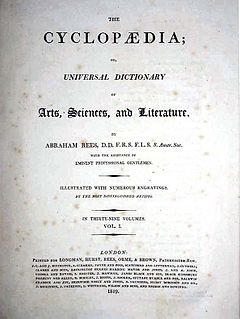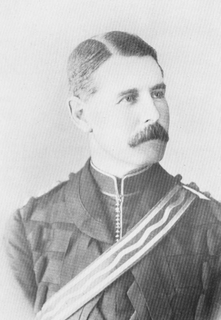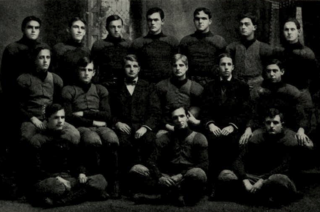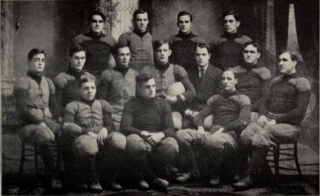
The Encyclopædia Britannica is a general knowledge English-language encyclopaedia which is now published exclusively as an online encyclopaedia. It was formerly published by Encyclopædia Britannica, Inc., and other publishers. It was written by about 100 full-time editors and more than 4,000 contributors. The 2010 version of the 15th edition, which spans 32 volumes and 32,640 pages, was the last printed edition.

Encyclopedia Americana is a general encyclopedia written in American English. It was the first major multivolume encyclopedia that was published in the United States. Following the acquisition of Grolier in 2000, the encyclopedia has been produced by Scholastic.

This section of the Timeline of United States history concerns events from 1790 to 1819.

George Grote was an English political radical and classical historian. He is now best known for his major work, the voluminous History of Greece.

The New Grove Dictionary of Music and Musicians is an encyclopedic dictionary of music and musicians. Along with the German-language Die Musik in Geschichte und Gegenwart, it is one of the largest reference works on the history and theory of music. Earlier editions were published under the titles A Dictionary of Music and Musicians, and Grove's Dictionary of Music and Musicians; the work has gone through several editions since the 19th century and is widely used. In recent years it has been made available as an electronic resource called Grove Music Online, which is now an important part of Oxford Music Online.

James Dwight Dana FRS FRSE was an American geologist, mineralogist, volcanologist, and zoologist. He made pioneering studies of mountain-building, volcanic activity, and the origin and structure of continents and oceans around the world.
The Encyclopædia Metropolitana was an encyclopedic work published in London, from 1817 to 1845, by part publication. In all it came to quarto, 30 vols., having been issued in 59 parts.

Chambers's Encyclopaedia was founded in 1859 by William and Robert Chambers of Edinburgh and became one of the most important English language encyclopaedias of the 19th and 20th centuries, developing a reputation for accuracy and scholarliness that was reflected in other works produced by the Chambers publishing company. The encyclopaedia is no longer produced. A selection of illustrations and woodblocks used to produce the first two editions of the encyclopaedia can be seen on a digital resource hosted on the National Museums Scotland website.

Rees's Cyclopædia, in full The Cyclopædia; or, Universal Dictionary of Arts, Sciences, and Literature was an important 19th-century British encyclopaedia edited by Rev. Abraham Rees (1743–1825), a Presbyterian minister and scholar who had edited previous editions of Chambers's Cyclopædia.

John Farey Jr. was an English mechanical engineering, consulting engineer and patent agent, known for his pioneering contributions in the field mechanical engineering.

Sir William Smith was an English lexicographer. He became known for his advances in the teaching of Greek and Latin in schools.

The Encyclopaedia of Islam (EI) is an encyclopaedia of the academic discipline of Islamic studies published by Brill. It is considered to be the standard reference work in the field of Islamic studies. The first edition was published in 1913–1938, the second in 1954–2005, and the third was begun in 2007.
Major-General Joseph Ellison Portlock was born at Gosport and was a British geologist and soldier, the only son of Nathaniel Portlock, and a captain in the Royal Navy.

Norwegian Folktales is a collection of Norwegian folktales and legends by Peter Christen Asbjørnsen and Jørgen Moe. It is also known as Asbjørnsen and Moe, after the collectors.

Henry Waugh Renny-Tailyour was an amateur all-round sportsman who appeared for Scotland in some of the earliest international football and rugby union matches, remaining to this day the only player to have represented the country in both codes. He also played first class cricket for Kent County Cricket Club and was an accomplished athlete.
The page details the timeline of History of Iran.
Captain Richard Tappin Claridge, FSA, was a prominent asphalt contractor and captain in the Middlesex UK Militia, who became best known for his prominent promotion of hydropathy, now known as hydrotherapy, in the 1840s. It was also known as the Cold Water system or Cold Water cure. Claridge is widely credited with introducing the methods of Vincent Priessnitz to England, thus initiating the populist movement of the time. Indeed, much of what is popularly known about Priessnitz in the English-speaking world comes from two seminal publications. Firstly, Claridge's Hydropathy; or The Cold Water Cure, as practised by Vincent Priessnitz.... Secondly, Richard Metcalfe's Life of Vincent Priessnitz (1898), with Metcalfe himself drawing upon Claridge, although Metcalfe also later wrote a historical overview and added more about Claridge and his role in the promotion of hydropathy.
Walter Alison Phillips was an English historian, a specialist in the history of Europe in the 19th century. From 1914 to 1939 he was the first holder of the Lecky chair of History in Trinity College, Dublin. Most of his writing is in the name of W. Alison Phillips, and he was sometimes referred to as Alison Phillips.

The 1906 New Hampshire football team was an American football team that represented New Hampshire College of Agriculture and the Mechanic Arts during the 1906 college football season—the school became the University of New Hampshire in 1923. Under first-year head coach Edward Herr, the team finished with a record of 2–5–1.

The 1907 New Hampshire football team was an American football team that represented New Hampshire College of Agriculture and the Mechanic Arts during the 1907 college football season—the school became the University of New Hampshire in 1923. Under second-year head coach Edward Herr, the team finished with a record of 1–5–2.















